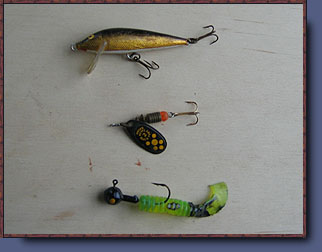Bass Fishing Tips:
|
Smaller bass can be readily caught at shallow depths by spin casting in or near to weed beds. Light and flexible spinning rods equipped with light monofilament line (6-pound test) are good for this purpose. A wide variety of fairly small spoons and spinners and plugs that mimic the appearance of minnows are used successfully as bait.
|

|
Brightly coloured plastic grubs and spinners trailed by a hook baited with worms are other examples of good attractants.
Although larger bass are sometimes caught in shallow water, most prefer the comparative security of deeper water in the 10- to 20-foot range.
Bass also prefer some form of cover and can sit in shadows afforded by weed beds, boulders and submerged logs or even under docks, bridges and anchored boats. Good localities for catching larger bass are along sections of rocky shoreline and around the margins of the gravel shoals. A combination of spin casting and still fishing with a spinner and a worm for bait works well. Try anchoring your boat at 15-foot depth along a suitable section of shoreline or shoal. Cast out parallel to the shore, retrieving slowly and allowing your bait to sink to a sub-vertical position near the bottom where you can still fish for a while before winding in and repeating the cast. You may be rewarded by a nibble that evolves into a vigorous tug of war with a large bass.
Large bass sometimes move into shallow water under the cover of night and linger for a while in the shadows afforded by weeds, brush and even the dock or the back of a boat moored in front of your cabin. Try quietly and cautiously approaching these areas on foot in the early morning hours and casting a tasty bait near the shaded area.
Finally, the bridge at the inlet to Carpenter Lake is a great place for bass and just a short walk from your cabin. Numerous rock bass, sunfish and junior smallmouth bass live under the bridge and present a wonderful and active fishing experience for children.